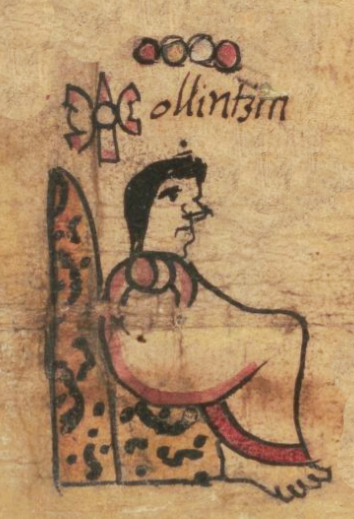Nahui Olintzin (CQ)
This simplex glyph-plus-notation represents the personal name, Nahui Olin or Nahui Olintzin (with the reverential ending). This is a day sign in the 260-day divinatory calendar, called the tonalpohualli in Nahuatl. Both Nahuas and Mixtecs included calendrics in their religious views of the cosmos.
Nahui means four, and olin means movement or earthquake. The notation is the upper part, and somewhat to the right. The sign for movement looks something like a butterfly, with an upright central, pointed axis that has a circle in the middle. To the right and left of this are two shapes that resembles ears or wings. These shapes vaguely resemble the more X-like shape of the olin glyphs in the Codex Mendoza. The numerical component consists of a horizontal row of four circles, drawn in black ink and filled in with colors: red, yellow, white, and red again (L-R).
Stephanie Wood
The historical context image shows that this name was given to a man of some significance, in that he sits on a jaguar-covered icpalli (throne) and wears a cape (tilmatli). Just as this Nahui Olin has, most people on this codex have calendrical names, reflecting (most often) the day they were born. Nahui Olin is often said to have had an association with the sun, tonatiuh, and therefore with life. The colorings on this glyph have associations with the cardinal directions, but the particular order of the colorants has yet to be understood.
The Codex Chimalpopoca, which contains the Annals of Cuauhtitlan and the Legends of the Suns in the year count (xiuhpohualli), says this about Nahui Olin: "4 Movement is the day sign of the fifth sun, called Movement Sun because it moves along and follows its course. And from what the old people say, there will be earthquakes in its time, and famine, and because of this we will be destroyed." [Quoted from John Bierhorst, The Codex Chimalpopoca (1992), 26.]
More about Nahui Olin: "Its back-and-forth pulsating, oscillating, and undulating was exemplified by bouncing rubber balls, pulsating hearts, respiring chests, labor contractions, earthquakes, and tremors" (Maffie 2014: 480–481). "Since it was four-phased and centering, it was depicted not only with the olin day glyph but also with quatrefoils, quincunxes, four-leaved flowers, butterflies, ball courts, and patolli game boards (Maffie 2014: 230–240, 481). The olin sign was one of the most used symbols or emblems among the Nahuas (Maffie 2014: 236)." [Quotes are from Isabel Laack, Aztec Religion and Art of Writing (2019), 142–143.] The reference to butterflies may explain the quasi-butterfly appearance of this glyph. Maffie (in Aztec Philosophy, 2014, 186) recognizes John Sullivan's emphasis on the linguistic distinction between olin (movement) and olli (rubber), but then goes on to argue that rubber can be impressive for its movement, citing Fray Diego de Durán, who also ties in the movement of the sun with the movement of the resin used for making rubber. Maffie goes even further to explain how he associates olin with teotl.
The central axis of this butterfly-like shape has been called a thorn, the placement of the pointed end indicating whether the sun is rising or setting or perhaps pointing east, the most important of the cardinal direction for the Nahuas. The circle in the middle has been called a chalchihuitl (jade bead) or a xictli (navel). [See James Maffie, Aztec Philosophy, 2014, 238–239.]
Stephanie Wood
ollintzin
Olintzin
Stephanie Wood
covers ruling men and women of Tecamachalco through 1593
ones, unos, rubber, hule, movimiento, temblores, terremotos, tlahtohqueh, tlahtoque, tlatoque, tlahtoani, Nahui Olin, ollin, xiuhpohualli, año, turquesa, xihuitl
The painter, artist, and Mexican model best known as Nahui Olin (given that name by Gerardo Murillo, a.k.a. Dr. Atl) was Carmen Mondragón (1893–1978). Artist Diego Rivera also helped make her famous in the 1920s. The use of Nahua names in this period reflects the concept of indigenismo of the period. This photo (retouched due to reflections from the glass) is reproduced from the one by Tufic Yazbek (1917–1979) that hangs in the Secretaría de Educación Pública, Museo Vivo del Muralismo. S. Wood, 7 May 2025.

nahui, four, https://nahuatl.wired-humanities.org/content/nahui
olin, earthquake, movement, https:nahuatl.wired-humanities.org/content/olin
tonalpohualli, calendar of 260 days, https:nahuatl.wired-humanities.org/content/tonalpohualli
cuatro movimiento
Ofelia Cruz Morales
The Codex Quetzalecatzin, aka Mapa de Ecatepec-Huitziltepec, Codex Ehecatepec-Huitziltepec, or Charles Ratton Codex. Library of Congress. https://www.loc.gov/item/2017590521/
The Library of Congress, current custodian of this pictorial Mexican manuscript, hosts a digital version online. It is not copyright protected.







